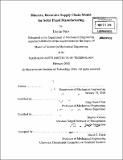Discrete, recursive supply chain model for solar panel manufacturing
Author(s)
Páez, Daýan
DownloadFull printable version (6.035Mb)
Other Contributors
Massachusetts Institute of Technology. Dept. of Mechanical Engineering.
Advisor
Jung-Hoon Chun and Stephen Graves.
Terms of use
Metadata
Show full item recordAbstract
A computer model to optimize global expansion of the production of solar panels is presented. The model is modular, extensible, and fast compared to existing specialized optimization software which use integer linear programming. The model inputs are (1) a tree of the assembly, or bill of materials (BOM), (2) a set of candidate locations where to build the product and any or all of its subcomponents, and (3) other cost drivers. As a tool for expansion, the model accounts for an already-existing manufacturing location that can expand production of one or more of the components. The number of factories to build per location is discrete. A full-combinatorial exploration of the parameter space is used to optimize recursively at every level of the BOM. The program output delineates where each component should be produced, and where and how much of it should be shipped, along with the associated costs. A second program operates in reverse: given a sourcing strategy, it outputs the net cost. In tandem, the two halves of the expansion model are used to explore parameter sensitivity and solution robustness of various hypothetical case studies. These tests reveal critical time horizons for expansion and the relative importance of material costs in driving the optimal sourcing scenario. Finally, a discussion on how to extend the programs is provided. The programs successfully account for the different nature of each cost driver; optimize according to the given constraints; and provide a fast, scriptable interface for parameter testing.
Description
Thesis (S.M.)--Massachusetts Institute of Technology, Dept. of Mechanical Engineering, 2010. Cataloged from PDF version of thesis. Includes bibliographical references (p. 93).
Date issued
2010Department
Massachusetts Institute of Technology. Department of Mechanical EngineeringPublisher
Massachusetts Institute of Technology
Keywords
Mechanical Engineering.